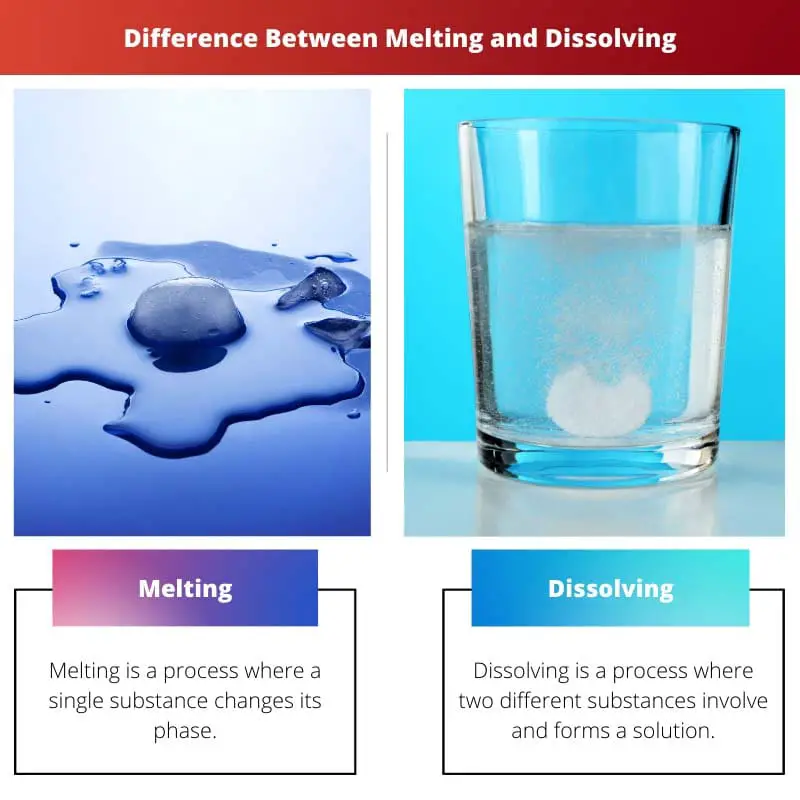Many products that an individual use in daily life had obtained from different processes. Melting and Dissolving are the processes used to find new substances or products.
Let’s dive into the Melting and Dissolving processes.
Key Takeaways
- Melting is the process of a solid changing to a liquid when heated. At the same time, dissolving is the process of a solid or gas becoming incorporated into a liquid to form a solution.
- Melting is a physical change that can be reversed by cooling while dissolving is a chemical change that cannot be easily reversed.
- Melting involves changing the state of matter while dissolving does not.
Melting vs Dissolving
The difference between Melting and Dissolving is that Melting is a process that physically transmits the phase of a substance. Dissolving is a chemical process where two substances are involved in solution establishment. The melting process involves a single solidity, and the Dissolving process involves double materials.

Melting is a physical process where a substance changes its phase. Melting is known as fusion over other words.
The Melting Process is used to liquefy the substances by heat. By applying heat or pressure, the internal energy of the solid substance will increase, and it tends to reach the melting point.
In Science, it had explained that solid substances interchange in a phase when the temperature has amplified.
Dissolving is different from melting. Dissolving is a chemical process where two substances form a single solution.
Another name for Dissolving is Dissolution. A solid material combines with a liquid phase particle to form a compound, known as the Dissolving process.
Two substances used to become fluid are known as Dissolving.
Comparison Table
| Parameters of Comparison | Melting | Dissolving |
|---|---|---|
| Meaning | Melting is a process where a single substance changes its phase. | Dissolving is a process where two different substances involve and forms a solution. |
| Process type | Melting is a physical process. | Dissolving is considered primarily as a chemical process. |
| Process Involved | The substances had liquefied by applying to heat. | A solid particle and a liquid combine to form a Fluid solution. |
| Difference | In the melting process, there is no use with solute and solvent | Dissolving involves the solute and solute in the process. |
| Example | Ice cream changing its phase into liquid. Unfreeze of Ice cubes. | Adjoin sugar into the water. Here sugar is a solute along the water are the solvents. |
What is Melting?
Melting is a process where a single substance changes its phase by heating. Melting is also known as fusion.
The internal energy of a solid material will increase when the temperature or pressure had applied. The intransitive verbs of Melting are melts, melting and melting.
To unfreeze 1g of ice, 334J of energy is required at a 0-degree temperature; this process is known as latent heat of melting. The opposite process of Melting is Freezing.
The Melting process is chief for chemical research, and the solid’s melting point had tested under normal conditions. The Melting Point is paramount for the storage and transport of solid particles.
Solutes and Solvents did not involve in the melting process. The Melting process had used to identify the substances.
The melting point range had required because all the solids do not melt at a specific temperature. Melting Points are different for various solids.
When impurities lie in the solid substances, the Melting Point Depression had used to lower the impurities in solid substances. A few of the related examples are:
- Melting of butter by heating.
- Candle melting when it is lightening up.
- Melting of steel and it needs a high temperature for melting.
- Melting of Gallium and can be melting at room temperature.
The particles will vibrate faster because the solid gains energy when the solid particle has heated and the solid start melting and converting into liquid. This is happening in Melting Process.

What is Dissolving?
Dissolving is a chemical process where a solid particle and liquid combine to form a solution. Solvents and Solutes involve in the dissolving process.
Solid particles had considered solutes, and Solvents are the solvents. Dissolving gives the fluid products.
Another name of Dissolving is Dissolution. Dissolving is different from Melting.
Dissolving involves physical processes, but most solutions are considered Chemical processes. If the dissolving process had favoured, then the substance is told to be soluble in the particular solvent.
Dissolving solidities were in liquid form. The dissolved solutions will not be separable with the filtration process.
Dissolving involves 3 steps to form a solution;
- It separates the particles of the solute.
- Separating the solvent particles from each other.
- Now a new solution takes place by combining the separated solute and solvent particles.
Dissolving occurs when the larger particles of a solute break down into smaller particles to form a new solution. Some of the examples are;
- Salt and water combination, here salt is a solute, along the water is a solvent.
- Stirring the solute like sugar in the solvent like water.
- Chromium and Iron had dissolved to form the stainless-steel products.
- Sugar, dissolved carbon dioxide, is the solute that dissolves with water to form a Soda solution.
The interaction of atoms in the dissolving process is a chemical reaction.

Main Differences Between Melting and Dissolving
- Melting is a process that occurs with a single substance where two substances with different phases are involved in the Dissolving process.
- Both Melting and Dissolving give the liquids as products, Melting is a physical process, whereas Dissolving is a chemical process.
- Solutes and Solvents are taking place in the dissolving process. In contrast, Solutes and Solvents do not involve in the melting process.
- A high range of temperatures and pressures had required to melt the large-scale solids. On the other hand, solute and solvent combine to form a solution.
- Ice cubes turning into a liquid phase is an example of the Melting Process. Salt solute combined with water is an example of the Dissolving process.

- https://www.cambridge.org/core/journals/journal-of-fluid-mechanics/article/melting-and-dissolving/1837D25366787BC88EC748B0E8F7D686
- https://pubs.rsc.org/en/content/articlehtml/2011/rp/c1rp90048j
- https://www.cambridge.org/core/journals/journal-of-fluid-mechanics/article/shaping-of-melting-and-dissolving-solids-under-natural-convection/87D15EEDEAB530D4E8A55F4BFC45F6B5

The process of dissolving is fascinating, and I appreciate the detailed explanation provided here.
Agreed! The article does well to explain the intricate details involved in dissolving.
Yes, the comparison table is particularly useful in understanding the differences between melting and dissolving.
The detail provided in this article is exceptional, making the differences between melting and dissolving very clear.
Absolutely, the article provides a comprehensive understanding of both processes.
The scientific explanation of both melting and dissolving is fascinating, and the impacts of temperature and pressure are particularly intriguing.
I agree, the article does well to highlight the scientific complexities involved in both processes.
The detailed explanation of both melting and dissolving processes is very informative and helpful.
I agree, the article provides a thorough understanding of the differences between the two processes.
Yes, the distinction between melting and dissolving is very clear in this article.
Interesting article! The distinction between melting and dissolving is very clear.
I agree, this article provides a thorough explanation of the differences between the two processes.
I found this article to be very informative, especially in terms of the chemical differences between melting and dissolving.
The detailed information provided in this article is exceptional – very helpful in understanding both processes.
Absolutely, the comparison between melting and dissolving is well-explained in this article.
I found the explanation of melting points and the significance of impurities in melting to be particularly enlightening.
Agreed, the section on melting points was especially informative.
I appreciate the scientific distinctions made in this article between melting and dissolving.
Absolutely, the article does an excellent job at clarifying the chemical and physical differences between the two processes.
As a fan of chemistry, I found this article to be incredibly engaging and educational.
I’m glad I stumbled upon this article – it provided a clear understanding of the processes involved in melting and dissolving.
I especially found the examples of melting and dissolving to be helpful in illustrating the concepts discussed.
The real-world examples provided throughout the article are helpful in understanding both melting and dissolving processes.
Absolutely, the article does an excellent job at providing practical examples to illustrate the concepts.
Yes, the examples of butter melting and ice cubes unfreezing were particularly illuminating.